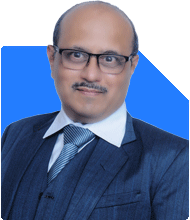21-Year-Old with 40k Salary & Savings - Need Investment Advice
Ramalingam Kalirajan |10924 Answers |Ask -Follow
Mutual Funds, Financial Planning Expert - Answered on Sep 12, 2024
He has an MBA in finance from the University of Madras and is a certified financial planner.
He is the director and chief financial planner at Holistic Investment, a Chennai-based firm that offers financial planning and wealth management advice.... more

Hi am prit 21 years old I am working at private sector salary of 40k recently started a sip of 2500 in ICICI prudential nifty 50 index fund have a savings of 62500 planning to save this amount and go for one time fix deposit but don't know what will be best. Want to invest more from my salary planning to go for mutual fund earlier invested in large cap not sure shall I go for small or mid cap please explain
In contrast, actively managed mutual funds are operated by professional fund managers who have the expertise to research, select, and manage assets with the goal of outperforming the benchmark. This can result in potentially better returns than what you’d receive with a passive index fund.
If you are looking to build wealth over time, consider allocating a portion of your savings into actively managed funds. Let a Certified Financial Planner (CFP) guide you in selecting mutual funds where managers actively assess market conditions and adjust portfolios to capture opportunities. This strategy can help you achieve higher returns than index funds, which merely track the market and do not take advantage of growth potential in specific sectors.
Active Funds Over Index Funds: Why It Matters
There are significant disadvantages to investing in index funds, especially for someone at the beginning of their financial journey. Here's why:
No Flexibility: Index funds don’t offer flexibility. Since they track a benchmark, they cannot adapt to market changes quickly, missing opportunities to capitalize on market trends.
Average Returns: While index funds provide stable returns, they are generally lower compared to actively managed funds in the long run. The goal of index funds is to match the market, not beat it.
Market Exposure: Index funds expose you to the entire market, including poorly performing sectors. Actively managed funds can shift away from sectors or companies that are not performing well, offering a more strategic approach to managing risk.
Active fund managers can manage a more focused portfolio, aiming to provide inflation-beating returns, which is what you need to grow your wealth faster. They can also diversify investments into emerging sectors and adjust the portfolio based on economic conditions.
Small-Cap and Mid-Cap Funds: Should You Consider Them?
Now, regarding your question on whether to invest in small-cap or mid-cap funds: these funds offer excellent growth potential but come with higher risk compared to large-cap funds. Let’s break down each:
Small-Cap Funds
Small-cap funds invest in smaller companies that are still in their growth phase.
These companies have high growth potential, but they are also more volatile. The stock prices can swing dramatically, making them a high-risk, high-reward investment.
Since you are still young, adding some small-cap exposure to your portfolio might benefit you, as it can potentially generate high returns over a long period. However, limit this to a small percentage (10-20%) of your total investments to avoid excessive risk.
Mid-Cap Funds
Mid-cap funds invest in companies that are more established than small-caps but still have significant growth potential.
These funds offer a good balance between risk and reward. Mid-cap companies are not as volatile as small-caps, and they generally provide better returns than large-caps.
For your portfolio, mid-cap funds could form a moderate portion, say 20-30%, to capture growth while managing risk.
Large-Cap Funds
These funds invest in the top companies with strong market leadership, typically stable and less volatile.
You may already have exposure to large-cap funds through your previous investments. They provide consistent but moderate returns. For long-term wealth accumulation, these funds should form the core of your portfolio.
Diversifying Your Portfolio: A Balanced Approach
Diversification is a crucial principle in building a robust portfolio. It’s not about putting all your money into one type of asset or fund. Diversifying allows you to balance risk and potential returns. Since you’ve already invested in large-cap funds and are thinking about small and mid-cap funds, let’s consider how to structure your portfolio for optimal growth with minimized risk:
Large-Cap Funds: 40-50% of your portfolio should be in large-cap funds. These provide stability and consistent growth.
Mid-Cap Funds: Allocate 20-30% to mid-cap funds. These offer growth potential while managing risk.
Small-Cap Funds: These can make up 10-20% of your portfolio. While riskier, they can also deliver substantial returns over a long period.
Debt Funds: Consider allocating 10-20% of your portfolio to debt funds or corporate bonds. These provide fixed-income returns and reduce the overall risk of your portfolio.
This diversified portfolio would ensure that you are not putting too much risk in any one area. It will allow your portfolio to grow steadily while managing the volatility of the market.
The Role of Fixed Deposits and Gold
You mentioned planning a one-time investment in a Fixed Deposit (FD). FDs are low-risk and provide guaranteed returns, but these returns are often lower than inflation, which means the real value of your money might diminish over time. FDs are suitable for short-term goals or emergency funds but are not ideal for long-term wealth creation.
Given your long investment horizon, I recommend focusing more on mutual funds, which can provide inflation-beating returns over the long term. However, keeping some money in FDs (perhaps for your emergency fund) is a good strategy to ensure liquidity for unforeseen circumstances.
On the other hand, investing in gold is a good hedge against inflation. Since you plan to invest Rs 50,000 in gold monthly, this should be part of your overall portfolio but not the primary focus. Gold can provide stability during market downturns, but it should only make up a small percentage (5-10%) of your investments. Too much gold investment may limit your returns, as gold generally grows slower than equities.
Insurance and Health Coverage
You have a term insurance plan, which is an excellent start. A term plan ensures that your family is financially secure if anything happens to you. However, you should periodically review your insurance coverage to ensure it aligns with your family’s growing needs, especially as you plan to expand your family. Your term insurance coverage should ideally be 10-12 times your annual income.
Regarding health insurance, relying solely on your employer’s health insurance might not be sufficient in the long run, particularly when you retire. Consider investing in a separate family health insurance plan with higher coverage, especially since medical costs are rising. Ensure that the plan covers all your family members, including your newborn.
National Pension System (NPS) and Retirement Planning
You’ve made a great decision by starting to invest in the National Pension System (NPS). The NPS offers tax benefits and helps create a long-term retirement corpus. As you are 21 years old, you have a long investment horizon ahead, and compounding can work wonders in your favor. However, ensure that you invest regularly and review your NPS portfolio to maintain an equity-debt balance.
Since you want to retire early, aim for higher contributions towards retirement-specific instruments like the NPS and equity mutual funds. This will help you build a corpus that can generate a stable income stream in your later years.
Steps to Consider Moving Forward
Increase SIP Contributions: As your salary grows, aim to gradually increase your SIP contributions. This will help you accumulate more over time and take advantage of compounding.
Review Your Portfolio Regularly: The mutual fund market changes frequently. Regular reviews, at least once a year, with a Certified Financial Planner (CFP) will help ensure your portfolio remains aligned with your goals.
Emergency Fund: Build an emergency fund that covers at least 6-12 months of your expenses. This should be kept in liquid funds or a high-interest savings account for easy access.
Avoid Overexposure to Gold: While gold is a good hedge, it should not dominate your portfolio. Focus more on equity mutual funds and other growth assets.
Stay Invested for the Long Term: The key to building wealth is to stay patient. Markets may fluctuate, but staying invested through ups and downs can yield significant returns in the long term.
Final Insights
Your current savings plan, particularly with your SIPs and investment in gold, shows a good start towards wealth accumulation. By diversifying your investments into mid and small-cap funds, increasing your exposure to actively managed funds, and maintaining discipline in your investment journey, you can ensure steady financial growth over time.
Make sure you stay consistent with your investments, review them regularly, and keep your retirement goals in mind. This disciplined approach will help you achieve financial security and growth over the long term.
Best Regards,
K. Ramalingam, MBA, CFP,
Chief Financial Planner,
www.holisticinvestment.in
You may like to see similar questions and answers below
Nitin Narkhede |113 Answers |Ask -Follow
MF, PF Expert - Answered on Sep 09, 2024
Ramalingam Kalirajan |10924 Answers |Ask -Follow
Mutual Funds, Financial Planning Expert - Answered on Oct 21, 2024
Ramalingam Kalirajan |10924 Answers |Ask -Follow
Mutual Funds, Financial Planning Expert - Answered on Jun 20, 2025
Ramalingam Kalirajan |10924 Answers |Ask -Follow
Mutual Funds, Financial Planning Expert - Answered on Sep 29, 2025
Reetika Sharma |435 Answers |Ask -Follow
Financial Planner, MF and Insurance Expert - Answered on Nov 12, 2025
Mayank Chandel |2583 Answers |Ask -Follow
IIT-JEE, NEET-UG, SAT, CLAT, CA, CS Exam Expert - Answered on Dec 24, 2025
Mayank Chandel |2583 Answers |Ask -Follow
IIT-JEE, NEET-UG, SAT, CLAT, CA, CS Exam Expert - Answered on Dec 24, 2025
Mayank Chandel |2583 Answers |Ask -Follow
IIT-JEE, NEET-UG, SAT, CLAT, CA, CS Exam Expert - Answered on Dec 24, 2025
Dr Dipankar Dutta |1842 Answers |Ask -Follow
Tech Careers and Skill Development Expert - Answered on Dec 23, 2025
Mayank Chandel |2583 Answers |Ask -Follow
IIT-JEE, NEET-UG, SAT, CLAT, CA, CS Exam Expert - Answered on Dec 23, 2025
Mayank Chandel |2583 Answers |Ask -Follow
IIT-JEE, NEET-UG, SAT, CLAT, CA, CS Exam Expert - Answered on Dec 23, 2025
Mayank Chandel |2583 Answers |Ask -Follow
IIT-JEE, NEET-UG, SAT, CLAT, CA, CS Exam Expert - Answered on Dec 23, 2025
Mayank Chandel |2583 Answers |Ask -Follow
IIT-JEE, NEET-UG, SAT, CLAT, CA, CS Exam Expert - Answered on Dec 23, 2025
Radheshyam Zanwar |6755 Answers |Ask -Follow
MHT-CET, IIT-JEE, NEET-UG Expert - Answered on Dec 23, 2025
Radheshyam Zanwar |6755 Answers |Ask -Follow
MHT-CET, IIT-JEE, NEET-UG Expert - Answered on Dec 23, 2025


























